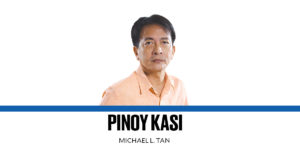The Google definition of Filipino is: “Filipinos are the people who are native to or identified with the country of the Philippines.” Simple but open-ended. “Filipinos” reminds me of a popular brand of Spanish biscuits that many years ago prompted some members of Congress to summon the foreign secretary to pressure him into filing a protest with Spain, over what some onion-skinned lawmakers thought was an insult to Filipinos. These cookies come in a number of flavors, but the classic is covered in milk chocolate. I do not think this half as insulting as a dark chocolate pastry with the politically incorrect name of “Negros” or “Negrillos.” Then Foreign Secretary Domingo Siazon defused the issue with two blunt questions: “Why should we complain? Do Austrians complain about Vienna sausages?” To which someone playfully commented: “Of course Austrians should complain, because Vienna sausages are smaller than German frankfurters!”
Then there were the ruffled feathers of those who wanted our ambassador to the Court of St. James to lodge a complaint against the Oxford English Dictionary (OED), which allegedly defined Filipino as “domestic helper.” A quick check proved this to be fake news; at most, the OED merely floated the present usage or the different nuances that go beyond what a word actually means.
Some months ago, our ambassador to London Antonio Lagdameo received a copy of the latest edition of the OED; its publishers explained that English as spoken and understood in the world today is global and not confined to what was then known as King’s English, or the language spoken in the United Kingdom. There are many strains of “World English” today: that spoken in the United States is called “American,” Singapore has “Singlish,” Australia has another type, and we have Philippine English that has enriched the OED with over two dozen words. Aside from “boondocks,” brought to the United States by veterans of the Philippine-American War, the OED now includes “kikay,” “kilig” and “tabo.”
Filipino came from “Felipe-nas,” the name given to Leyte-Samar by Ruy Lopez de Villalobos in 1543 to honor the then Spanish Crown Prince Felipe. We cannot revert to an original or old name because nobody noted it down, so we have a current bill in Congress that seeks to establish a Philippine geographic renaming commission. Like it or not, the Philippine archipelago and the nation as we know it today was formed through a colonial experience under Spain and the United States. If we go back to Villalobos, we can probably change Filipinas to Caesaria Caroli, the name given Mindanao in honor of Charles V, the holy Roman emperor best remembered in the Philippines today for Carlos Primero, the popular Spanish brandy. Unfortunately, under this name, Filipinos would be Carolinos or Carolinians.
We can also play what-if and say that Magellan was Portuguese, and if Manuel of Portugal had funded the Magellan expedition instead of the Spanish Crown, Filipinos would be Manuelans today, a name that may confuse our nationality with the name of a Mandaluyong shopping mall.
Naming is important because we need it for branding. Champagne, for example, is reserved for a fizzy drink from a particular place in France; any similar thing made elsewhere is not champagne but sparkling wine. Mangas de Manila, for example, are Mexican mangoes, fruit immigrants that traveled from Manila to Acapulco in the days of the Galleon Trade.
History can also be used to contest images and imagery. The Merlion is the icon or symbol of Singapore, just as the Eiffel Tower is for Paris. Thorough and effective nation-branding by the Singapore Tourism Board in the 1970s built on the ideas of “Temasek” (sea) and “Singapura” (Lion City) to create the Merlion that has come to be the symbol of Singapore. The image is internationally recognized, unlike the Merlion in the Seal of Manila or the trademark of San Miguel Beer.
In 1596, Philip II of Spain conferred a coat of arms to the title “distinguished and ever loyal city of Manila.” Drawing from the Lion (Leon) and Castle (Castilla) that are still found in the coat of arms and flag of Spain, heraldic designers took into account that the Philippines was an overseas (ultramar) possession and crafted for it a symbol that was half-lion and half-dolphin. Our lack of appreciation for our history resulted in the appropriation of our Merlion.
Comments are welcome at aocampo@ateneo.edu


